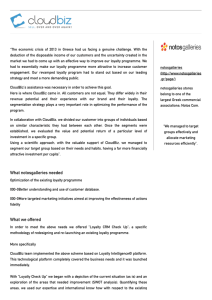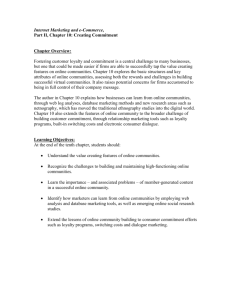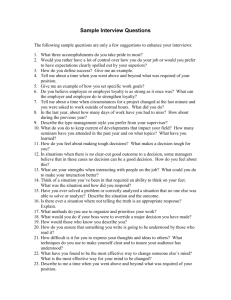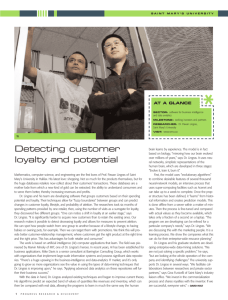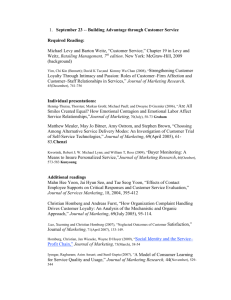advertisement
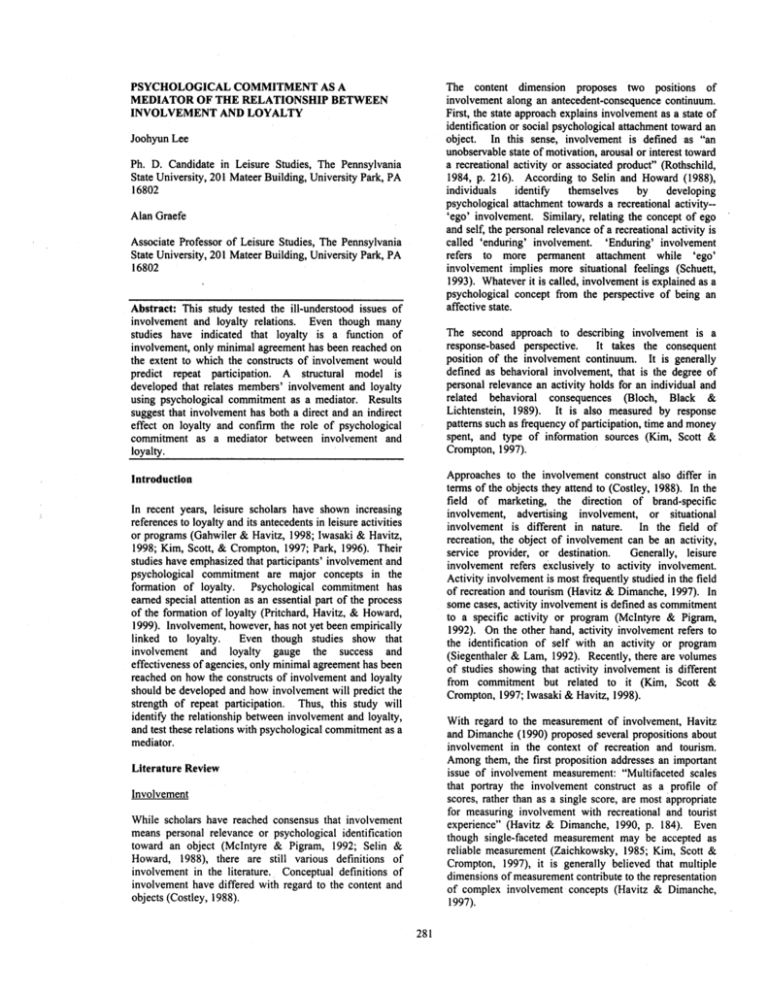
PSYCHOLOGICAL COMMITMENT AS A MEDIATOR OF THE RELATIONSHIP BETWEEN INVOLVEMENT AND LOYALTY The content dimension proposes two positions of involvement along an antecedent-consequence continuum. First, the state approach explains involvement as a state of identification or social psychological attachment toward an object. In this sense, involvement is defined .as "an unobservable state of motivation, arousal or interest toward a recreational activity or associated product" (Rothschild, 1984, p. 216). According to Selin and Howard (1988), individuals identify themselves by developing psychological attachment towards a recreational activity-'ego' involvement. Similary, relating the concept of ego and self, the personal relevance of a recreational activity is called 'enduring' involvement. 'Enduring' involvement refers to more permanent attachment while 'ego' involvement implies more situational feelings (Schuett, 1993). Whatever it is called, involvement is explained as a psychological concept from the perspective of being an affective state. Joohyun Lee Ph. D. Candidate in Leisure Studies, The Pennsylvania State University, 201 Mateer Building, University Park, PA 16802 Alan Graefe Associate Professor of Leisure Studies, The Pennsylvania State University, 201 Mateer Building, University Park, PA 16802 Abstract: This study tested the ill-understood issues of involvement and loyalty relations. Even though many studies have indicated that loyalty is a function of involvement, only minimal agreement has been reached on the extent to which the constructs of involvement would predict repeat participation. A structural model is developed that relates members' involvement and loyalty using psychological commitment as a mediator. Results suggest that involvement has both a direct and an indirect effect on loyalty and confirm the role of psychological commitment as a mediator between involvement and loyalty. The second approach to describing involvement is a response-based perspective. It takes the consequent position of the involvement continuum. It is generally defined as behavioral involvement, that is the degree of personal relevance an activity holds for an individual and related behavioral consequences (Bloch, Black & Lichtenstein, 1989). It is also measured by response patterns such as frequency of participation, time and money spent, and type of information sources (Kim, Scott & Crompton, 1997). Approaches to the involvement construct also differ in terms of the objects they attend to (Costley, 1988). In the field of marketing, the direction of brand-specific involvement, advertising involvement, or situational involvement is different in nature. In the field of recreation, the object of involvement can be an activity, service provider, or destination. Generally, leisure involvement refers exclusively to activity involvement. Activity involvement is most frequently studied in the field of recreation and tourism (Havitz & Dimanche, 1997). In some cases, activity involvement is defined as commitment to a specific activity or program (McIntyre & Pigram, 1992). On the other hand, activity involvement refers to the identification of self with an activity or program (Siegenthaler & Lam, 1992). Recently, there are volumes of studies showing that activity involvement is different from commitment but related to it (Kim, Scott & Crompton, 1997; Iwasaki & Havitz, 1998). Introduction In recent years, leisure scholars have shown increasing references to loyalty and its antecedents in leisure activities or programs (Gahwiler & Havitz, 1998; Iwasaki & Havitz, 1998; Kim, Scott, & Crompton, 1997; Park, 1996). Their studies have emphasized that participants' involvement and psychological commitment are major concepts in the formation of loyalty. Psychological commitment has earned special attention as an essential part of the process of the formation of loyalty (Pritchard, Havitz, & Howard, 1999). Involvement, however, has not yet been empirically linked to loyalty. Even though studies show that involvement and loyalty gauge the success and effectiveness of agencies, only minimal agreement has been reached on how the constructs of involvement and loyalty should be developed and how involvement will predict the strength of repeat participation. Thus, this study will identify the relationship between involvement and loyalty, and test these relations with psychological commitment as a mediator. With regard to the measurement of involvement, Havitz and Dimanche (1990) proposed several propositions about involvement in the context of recreation and tourism. Among them, the first proposition addresses an important issue of involvement measurement: "Multifaceted scales that portray the involvement construct as a profile of scores, rather than as a single score, are most appropriate for measuring involvement with recreational and tourist experience" (Havitz & Dimanche, 1990, p. 184). Even though single-faceted measurement may be accepted as reliable measurement (Zaichkowsky, 1985; Kim, Scott & Crompton, 1997), it is generally believed that multiple dimensions of measurement contribute to the representation of complex involvement concepts (Havitz & Dimanche, 1997). Literature Review Involvement While scholars have reached consensus that involvement means personal relevance or psychological identification toward an object (McIntyre & Pigram, 1992; Selin & Howard, 1988), there are still various definitions of involvement in the literature. Conceptual definitions of involvement have differed with regard to the content and objects (Costley, 1988). 281 As multifaceted measurement better represents involvement concepts, the dimensions of involvement is another issue. Generally, involvement dimensions developed by Laurent and Kapferer (1985) are adopted and modified in leisure and recreation studies. Their study suggested a multidimensional approach with five facets: interest, pleasure, sign, risk importance, and risk probability. While this scale was developed exclusively for consumer goods and services, recreation scholars adjusted it to the concept of recreation and tourism. repetition over some period (Jacoby & Kyner, 1973). This concept allows the categorization of the extent of loyalty as high, spurious, latent, and absent (Backman & Crompton, 1991; Dick & Basu, 1994). Recently, an alternative explanation of loyalty formation has been suggested. Some researchers have argued that the integration of behavioral and attitudinal loyalty does not reflect the sensitive underlying development of the loyalty process (Iwasaki & Havitz, 1998). Therefore, it has been suggested that access to consumers' beliefs, affect, and intention phases in the attitude-behavior development structure would contribute to the development of the construct of loyalty (Oliver, 1999). Consumers develop loyalty following a cognition-affect-intention pattern and become loyal at each attitudinal phase. That is, consumers become loyal in a cognitive phase first and then in. an affective manner, followed by an intentional stage and, finally, they express loyalty behaviorally. Most researchers accept three dimensions of involvement in recreation and leisure (Havitz & Dimanche, 1997). First, perceived importance/interest of activity has been an essential part of involvement (Selin & Howard, 1988; Schuett, 1993; Havitz & Dimanche, 1990, Park, 1996). Every current study includes importance/interest as a facet in the construction of involvement (Havitz & Dimanche, 1997). Enjoyment/pleasure value has been also embraced as a major dimension of involvement in the leisure literature because it reflects a significant element of the leisure concept (Selin & Howard, 1988; Siegenthaler & Lam, 1992; Park, 1996). In addition, sign/self-expression value has been identified as another major component of involvement (Kim, Scott & Crompton, 1997; Mcintyre & Pigram, 1992). The first phase of loyalty is cognition that is developed through available information. This loyalty is based on consumers' belief that the available information indicates one option is preferable to its alternatives. Cognitive consideration includes accessibility, confidence, centrality, and clarity (Dick & Basu, 1994). However, this stage of loyalty is more likely to be another concept of involvement rather than loyalty itself. The next stage is affective loyalty, which is developed in terms of satisfying experiences. In this phase of loyalty, the consumer develops a liking for or a preferential attitude toward the brand. Examples of affective loyalty are emotion, feeling, mood, and primary affect. Yet, there are also difficulties in effectively measuring the affective side ofloyalty. Many authors suggest that loyalty and involvement are different constructs and involvement is an antecedent of loyalty (Park, 1996; Siegenthaler & Lam, 1992; Iwasaki & Havitz, 1998). Related to recreational activity, Siegenthaler and Lam (1992) compared loyalty and involvement, suggesting that loyalty is a consistent behavior that involves dedication and consistency, while involvement is self-identification with an activity. Therefore, loyalty focuses more on behavior and attitude while involvement comprises self-image, interest, centrality, and importance. Even though a substantial amount of research suggests that involvement plays an important role in the formation of loyalty, no empirical studies have been conducted to date to explore the linkage between these constructs. Conative loyalty is developed after the cognitive and affective phases. It implies the behavioral intention to repurchase the brand. This stage of loyalty is defined as "a brand-specific commitment to repurchase" (Oliver, 1999,p. 35). Therefore, a consumer experiencing conative loyalty appears to be deeply committed to participate at first. Generally, loyalty is defined as the behavioral intention to maintain an ongoing relationship (Sheth, Sisodia & Sharman, 2000). Also, Andressen and Lidestad (1998) operationalized loyalty as participants' repurchase intentions and intentions to recommend to others. The loyalty construct has earned considerable attention not only in the field of consumer behavior but also in leisure research (Backman & Crompton, 1991; Iwasaki & Havitz, 1998). The development of the construct of loyalty has evolved within the framework of behavioral, attitudinal, and composite concepts in the field of marketing. First, loyalty was defined as an overt behavior or consequences of behavior (Cummingham, 1956). Therefore, it centers on repeat patterns of the same brand over time. Later, the attitudinal component of loyalty earned attention as a better way of understanding the underlying psychological phenomenon behind behavior. Thus, the attitudinal definition of loyalty focuses on customers' preferences and emotional attachment (Day, 1969). Then, the composite conceptualization of loyalty emerged. In this notion, loyalty is viewed as a two-dimensional phenomenon that is a function of psychological attitudes and behavioral Commitment From a sociological perspective, the concept of commitment is explained as consistent behavior over some period caused by social pressure or side bet (Becker, 1960). Therefore, behavioral consistency and outside influences are important facets of commitment. Extending this view, Johnson (1973) proposed two distinct meanings: personal commitment and behavioral commitment. Personal commitment refers to an individual's dedication to achieve a line of action. Behavioral commitment is a consistent behavior, which consists of social and cost components. Unlike the sociological definition that emphasizes the social aspect of commitment, the psychological perspective 282 stresses the role of personal commitment. Commitment is the "emotional or psychological attachment to a brand...[that] is usually considered in purely cognitive terms that measure consumer attitudes of attachment to a brand" (Pritchard, Havitz & Howard, 1999, p. 334). According to Buchanan (1985), commitment is defined as "the pledging or binding of an individual to behavioral acts which result in some degree of affective attachment to the behavior" (p. 402). Therefore, psychological attachment is considered as a key component of commitment. psychological commitment (Crosby & Taylor, 1983) as a basis for the operationalization of the Psychological Commitment Instrument (PCI). The primary aspect of the PCI is symbolic consistency that measures overall reluctance to change important associations with service. The second factor of PCI is volition, which is related to components of free choice and control in one's preference for a service. Positional involvement is the third factor and refers to personal values and self-images perceived in association with a service. Additionally, informational complexity, which deals with ones' cognitive structure and how consumers manage information about their preference, contributed to the measurement of commitment (Pritchard, Havitz, & Howard, 1999). According to the previous studies, it is evident that psychological commitment plays an essential role in the formation of true loyalty. Therefore, it is suggested that psychological commitment has a direct effect on loyalty. Also, involvement influences the construct of loyalty. However, it is not clear if involvement has a direct or indirect effect on loyalty and how much it will influence the strength of loyalty. Therefore, this paper addresses: I) the relationship between involvement and loyalty, and 2) whether psychological commitment functions as a mediator between involvement and loyalty. The hypothesized model and its null model of involvement, commitment, and loyalty are shown in Figure I. Many researchers have arrived at an increasingly accepted consensus that commitment and loyalty are different but related concepts (Pritchard, Havitz & Howard, 1999; Kim, Scott & Crompton, 1997). Dick and Basu (1994) indicated that relative attitude is predicted by the strength of psychological antecedents, that is, commitment influences loyalty. Further, models provided by previous studies confirm that commitment serves as a predictor of loyalty and repatronage (Dick & Basu, 1994; Pritchard, Havitz & Howard, 1999). Related to the role of commitment in loyalty, Jacoby and Kyner (1973) explained that ''the notion of commitment provides an essential basis for distinguishing between brand loyalty and other forms of repeat purchasing behavior and holds promise for assessing the relative degrees of brand loyalty"(p. 3). Also, Samuelsen and Sandvik (1997) insisted that loyalty results from commitment for two main reasons: affective reasons and cognitive motives. Affective commitment is an emotional attachment to the brand while calculative commitment refers to perceived risk in performance among alternatives. In conclusion, commitment that focuses on psychological attachment is an antecedent of loyalty that extends the meaning of loyalty over a simple habitual purchase and preference. Methods Study Sample The subjects for this study are YMCA members who A purchased a. membership within the last year. convenience sample of 152 subjects was drawn from the Bellefonte Pennsylvania Family YMCA. The sample consisted of approximately 60% females with an average age of 41 years. More than 70% of the respondents were married and had a college background. As an improvement in the measurement of commitment, Pritchard, Howard, and Havitz (1992) adapted the theory of Hypothesized Model Null Model Figure 1. Hypothesized Model and Null Model of Involvement and Commitment and Their Linkage to Loyalty 283 Instrumentation on psychological commitment and psychological commitment has a direct and positive effect on loyalty. Estimates for the structural model are contained in Table I. Results of the paths in the null model suggest that involvement affected psychological commitment. The effects of involvement were positive and significant. Further, psychological commitment influenced loyalty directly and positively. The goodness of fit indices of the null model support the role of psychological commitment as a mediator of the relation between involvement and loyalty. Measurement of involvement used a three-dimension involvement scale that is frequently used in the field of recreation and leisure (Havitz & Dimanche, 1997). The dimensions were perceived importance/interest, enjoyment/pleasure, and sign/self-expression value (10 items). Loyalty was measured with the conative loyalty scale. Conative loyalty has been proven by many researchers to be a good indicator of the .construct of loyalty (Andressen & Lidestad, 1998; Webster & Sundaram, 1998; Singh & Sirdeshmukh, 2000). Conative loyalty asks about intention of repatronage and advertising by word of mouth (4 items). Psychological commitment was measured with parts of the PCI (Pritchard, Havitz & Howard, 1999). Resistance to change, volitional choice, and informational complexity were the indicators used to measure psychological commitment (5 items). The examination of the path between involvement and loyalty in the null model suggests an indirect effect of involvement on loyalty. The estimated parameter between involvement and loyalty is .40 (.60 x .67). On the other hand, an estimate of psychological commitment to loyalty is .67. This indicates that the effect of involvement on loyalty is smaller than the effect of psychological commitment on loyalty, confirming the importance Of the role of psychological commitment to explain loyalty. But, is it true that psychological commitment has a bigger effect on loyalty compared to involvement? Results Prior to testing the structural model in Figure I, a confirmatory factor analysis (CFA) was conducted to assess the statistical fit of the observed data. Measurement of CFA and the structural equation model were examined with EQS 4.0, a structural equations program. Since every dimension of each factor was specified in advance by theory, CFA can allow for correlation among factors if theoretically justified. CFA produced a chi-square statistic of 253.9 (df=149, p< .01), with a comparative fit index (CFI) and non-normed fit index (NNFI) of .93 and .94, respectively. Further, it generated standardized RMR (SRMR) and root mean square error (RMSEA) values of .07, indicating an acceptable level of fit to the data (Figure 2). Although certainly of concern, the overall fit of the measurement model was of secondary importance in the study. The primary concern was to examine the hypothesized causal relations between involvement and loyalty and to test the role of psychological commitment between them. To test the relationship between involvement and loyalty, a direct path was added between them. The hypothesized model met the fitness criteria with an acceptable level (Table I). Then, the chi-square difference test was employed to determine whether the hypothesized model performed better than the null model (Bagozzi & Yi, 1988). Results showed that the hypothesized model provided a significant improvement over the null model: 'l = 283.1 and X2 = 230.8 respectively (with I degree of freedom difference). In the hypothesized model, the total effect of psychological commitment is simply the direct effect associated with the path to loyalty (.58). In contrast, the total effects of involvement are defined by the sum of its direct and indirect effects (.58 x.24 + .51 = .65). This total effect is bigger than the total effect of psychological commitment. Therefore, the importance of involvement for explaining loyalty cannot be underestimated. To test the role of psychological commitment between involvement and loyalty, the hypothesis of the null model was examined: Involvement has a direct and positive effect Table 1. Estimates for the Null Modeland Hypothesized Model Null Model Parameter Involvement ~ Commitment Commitment ~ Loyalty Hypothesized Model Estimates Parameter Involvement ~ Commitment Commitment ~ Loyalty Involvement ~ Loyalty .60 * .67 * Goodness of fit indices Chi-square Non-normed fit index Comparative fit index Standardized RMR Root mean sq. error of app. *p>.05 = 283.1 (df=I44) =.94 =.95 =.08 =.07 = 230.8 (df= 143) =.94 = .95 =.07 =.06 284 Estimates .51* .58 * .24 * Involvement .56 Loyalty NOTE:Chi-square= 253.54 (df.149); Bentler-Bonett Nonnormed fit index(NNFl) / Comparative fit index (CFl)':" .93 / .94; Standardized RMR (SRMR)/ Root Mean SQ. Error of App, (RMSEA) = .07 / .07 Figure 2. Estimates for Measurement Model 285 Discussion and Conclusion Backman, S., & Crompton, J. (1991). Differentiating between high, spurious, latent, and low loyalty participants in two leisure activities. Journal of Park and Recreation Administration. 9(2), 1-17. Several things should be noted concerning the results shown in Table I. First, results for the two models of mediation show that the effect of psychological commitment is present. Even though some researchers still recognize loyalty .and psychological commitment as identical concepts (Park, 1996; Buchanan, 1985;Jacoby & . Kyner, 1973), there is increasing consensus that commitment and loyalty are different and psychological commitment is an important antecedent of the structure of loyalty(Pritchard, Havitz, & Howard, 1999;Kim, Scott, & Crompton, 1997). The findings of this study confirm the existence of a mediator between involvement and 'loyalty, and show the important role of psychological commitment in this relationship. Therefore, managers may strengthen loyalty by maximizing the strategies that emphasize the dimensions of psychological commitment. For example, using diverse information sources such as the Internet and newspapers can increasethe consumers' information search dimension. Bagozzi, P., & Yi, Y. (1988). On the evaluation of structural equation models. Journal of the Academy of MarketingScience. 16(Spring), 74-94. Becker, H. (1960). Notes on the concept of commitment. The American Journalof Sociology. 66(1), 32-40. Block, P., Black, W., & Lichtenstein, D. (1989). Involvement with the equipmentcomponentof sport: Links to recreational commitment. LeisureSciences. 11. 187-200. Buchanan, T. (1985). Commitment and leisurebehavior: A theoretical perspective. LeisureSciences.7(4), 401-420. Costely, C. (1988). Meta analysis of involvement research. Advances in ConsumerResearch. 15.554-562. Second,the importance of involvement to loyaltyshouldbe recognized. The model developed in this study suggests the strong influence of involvement on loyalty. The model suggested two significant paths between involvement and loyalty: a direct effect and an indirect effect through a mediator. Even though the direct effect of involvement on loyalty was smaller than the direct influence of commitment on loyalty, the total effects of the constructs suggest that involvement is an equally important predictor of loyalty. Even though many studies have implied that involvement predicts loyalty,no empirical linkagehas been revealedto explorethe path betweenthem. The findings of this study emphasize the importance of involvement to explain the strength of loyalty, as the model supported a strong linkagebetweenthem. Therefore, it is important for managers to focus on providing interesting and enjoyable programs to members, which may lead to increased repatronage by the members. Crosby, L., & Taylor,J. (1983).Psychological commitment and its effects on postdecision evaluation and preference stability among voters. Journal of Consumer Research. 9. 413-431. Cunningham, R. (1956). Measurement of brand loyalty. The marketina revolution. ProCeedings of the 37th Conference of the American Marketing Association (pp. 39-45).Chicago: American MarketingAssociation. Day, G. S. (1969). A two-dimensional concept of brand loyalty.Journalof Advertising Research.9(3), 29-35. Dick, A. S., & Basu, K. (1994). Customer loyalty: Toward an integrated conceptual framework. 19urnal of the Academy of Marketina Science.22(2), 99-103. Gahwiler, P., & Havitz, M. (1998). Toward a relational understanding of leisure social worlds, involvement, psychological commitment, and behavioral loyalty. Leisure Sciences. 20. 1-23. Several suggestions may be made to improve further studies. The primary limitation of this study is its generalizability. Even though membersof the YMCA were well suited to examine the theoretical linkage among the concepts, the small size of the sample from only one YMCAmay be questioned. Additional researchis required that allows for improved generalizability. Also, the construct of loyalty is debatable. Several studies have recognized the deficiency of the operationalization of loyalty and the effort to reveal the concrete conceptualization of loyalty is still an undergoing process. Even though the intentional aspect of loyalty is well established as a dependable definition, more investigation of the loyaltyconstructis needed. Havitz,M., & Dimanche, F. (1990).Propositions for testing the involvement construct in recreational and tourism contexts. LeisureSciences. 12. 179-195. Havitz, M., & Dimanche, F. (1997). Leisure involvement revisited: Conceptual conundrums and measurement advances. JournalofLeisure Research. 29(3),245-278. Iwasaki,Y., & Havitz, M. (1998).A path analytic model o~ the relationships between involvement, psychcloglcal commitment, and loyalty. Journal of Leisure Research. J,Q(2), 256-280. References Jacoby, J., & Kyner, D. (l973).Brand loyalty vs, repeat purchasing behavior. Journal of MarketingResearch. 10. 19. Andreassen, T., & Lindestad, B. (1998). The effect of corporate image in the formation of customer loyalty. Journal of ServiceResearch. 1(1),82-92. 286 Johnson, M. (1973). Commitment: A conceptual structure and empirical application. The Sociological Quarterly, 14(Summer),395-406. Rothschild, M. (1984). Perspectives on involvement: Current problems and future directions. Advances in Consumer Research. II, 216-217. Kapferer, J., & Laurent, G. (1985). Consumer's involvement profile: New empirical results. Advances in Consumer Research. 12.290-295. Schuett, M. (1993). Refining measures of adventure recreation involvement. Leisure Sciences. 15. 205-216. Selin, S., & Howard, D. (1988). Ego involvement and leisure behavior: A conceptual specification. Journal of Leisure Research, 20(3), 237-244. Kim, S., Scott, D., & Crompton, J. (1997). An exploration of the relationships among social psychological involvement, behavioral involvement, commitment, and future intentions in the context of birdwatching. Journal of Leisure Research, 29(3), 320-341. Seth, 1., Sisodia, R, & Sharma, A. (2000). The antecedents and consequences of customer-centric marketing. Journal of the Academy of Marketing. 28(1), 55-66. McIntyre, N., & Pigram, J. (1992). Recreation specialization reexamined: The case of vehicle-based campers. Leisure Sciences. 14.3-15. Siegenthaler, K., & Lam, T. (1992). Commitment and ecoinvolvement in recreational tennis. Leisure Sciences, 14, 303-315. Qliver, R. L. (1999). Whence consumer loyalty? Journal of Marketing. 63(Special), 33-44. Singh, J., & Sirdeshmukh, D. (2000). Agency and trust mechanisms in consumer satisfaction and loyalty judgments. Journal of the Academy of Marketing Science, 28(1), 150-167. Park, S. (1996). Relationship between involvement and attitudinal loyalty constructs in adult fitness programs. Journal of Leisure Research. 28(4), 233-250. Webster, C., & Sundaram, D. (1998). Service consumption criticality in failure recovery. Journal of Business Research. u, 153-159. Prichard, M., Havitz, M., & Howard, D. (1999). Analyzing the commitment-loyalty link in service contexts. Journal of the Academy of Marketing Science. 27(3), 333-348. Zaichkowsky, J. (1985). Measuring the involvement construct. Journal of Consumer Research, 12(3), 341-352. Pritchard, M., & Howard, D. (1992). Loyalty measurement: A critical examination and theoretical extension. Leisure Sciences. 14, 155-164. 287



